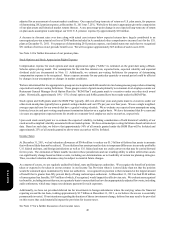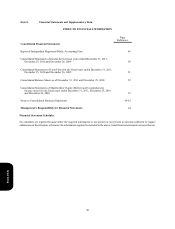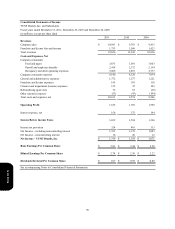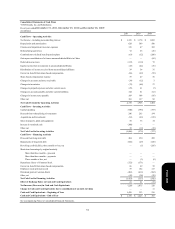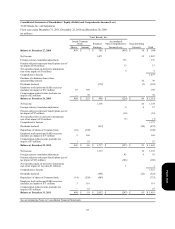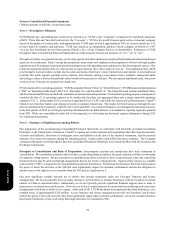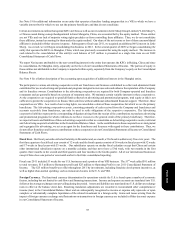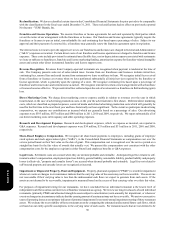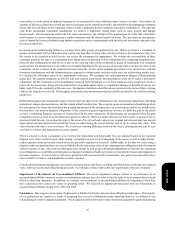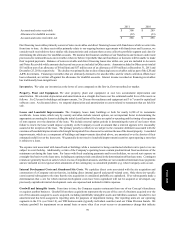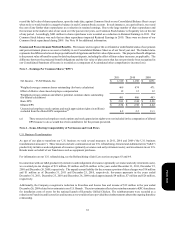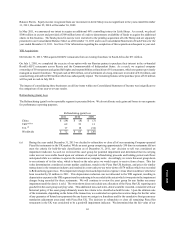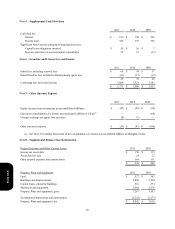Pizza Hut 2011 Annual Report Download - page 160
Download and view the complete annual report
Please find page 160 of the 2011 Pizza Hut annual report below. You can navigate through the pages in the report by either clicking on the pages listed below, or by using the keyword search tool below to find specific information within the annual report.
56
Reclassifications. We have reclassified certain items in the Consolidated Financial Statements for prior periods to be comparable
with the classification for the fiscal year ended December 31, 2011. These reclassifications had no effect on previously reported
Net Income - YUM! Brands, Inc.
Franchise and License Operations. We execute franchise or license agreements for each unit operated by third parties which
set out the terms of our arrangement with the franchisee or licensee. Our franchise and license agreements typically require the
franchisee or licensee to pay an initial, non-refundable fee and continuing fees based upon a percentage of sales. Subject to our
approval and their payment of a renewal fee, a franchisee may generally renew the franchise agreement upon its expiration.
The internal costs we incur to provide support services to our franchisees and licensees are charged to General and Administrative
(“G&A”) expenses as incurred. Certain direct costs of our franchise and license operations are charged to franchise and license
expenses. These costs include provisions for estimated uncollectible fees, rent or depreciation expense associated with restaurants
we lease or sublease to franchisees, franchise and license marketing funding, amortization expense for franchise-related intangible
assets and certain other direct incremental franchise and license support costs.
Revenue Recognition. Revenues from Company-operated restaurants are recognized when payment is tendered at the time of
sale. The Company presents sales net of sales-related taxes. Income from our franchisees and licensees includes initial fees,
continuing fees, renewal fees and rental income from restaurants we lease or sublease to them. We recognize initial fees received
from a franchisee or licensee as revenue when we have performed substantially all initial services required by the franchise or
license agreement, which is generally upon the opening of a store. We recognize continuing fees based upon a percentage of
franchisee and licensee sales and rental income as earned. We recognize renewal fees when a renewal agreement with a franchisee
or licensee becomes effective. We present initial fees collected upon the sale of a restaurant to a franchisee in Refranchising (gain)
loss.
Direct Marketing Costs. We charge direct marketing costs to expense ratably in relation to revenues over the year in which
incurred and, in the case of advertising production costs, in the year the advertisement is first shown. Deferred direct marketing
costs, which are classified as prepaid expenses, consist of media and related advertising production costs which will generally be
used for the first time in the next fiscal year and have historically not been significant. To the extent we participate in advertising
cooperatives, we expense our contributions as incurred which are generally based on a percentage of sales. Our advertising
expenses were $593 million, $557 million and $548 million in 2011, 2010 and 2009, respectively. We report substantially all of
our direct marketing costs in Occupancy and other operating expenses.
Research and Development Expenses. Research and development expenses, which we expense as incurred, are reported in
G&A expenses. Research and development expenses were $34 million, $33 million and $31 million in 2011, 2010 and 2009,
respectively.
Share-Based Employee Compensation. We recognize all share-based payments to employees, including grants of employee
stock options and stock appreciation rights (“SARs”), in the Consolidated Financial Statements as compensation cost over the
service period based on their fair value on the date of grant. This compensation cost is recognized over the service period on a
straight-line basis for the fair value of awards that actually vest. We present this compensation cost consistent with the other
compensation costs for the employee recipient in either Payroll and employee benefits or G&A expenses.
Legal Costs. Settlement costs are accrued when they are deemed probable and estimable. Anticipated legal fees related to self-
insured workers' compensation, employment practices liability, general liability, automobile liability, product liability and property
losses (collectively, "property and casualty losses") are accrued when deemed probable and estimable. Legal fees not related to
self-insured property and casualty losses are recognized as incurred.
Impairment or Disposal of Property, Plant and Equipment. Property, plant and equipment (“PP&E”) is tested for impairment
whenever events or changes in circumstances indicate that the carrying value of the assets may not be recoverable. The assets are
not recoverable if their carrying value is less than the undiscounted cash flows we expect to generate from such assets. If the
assets are not deemed to be recoverable, impairment is measured based on the excess of their carrying value over their fair value.
For purposes of impairment testing for our restaurants, we have concluded that an individual restaurant is the lowest level of
independent cash flows unless our intent is to refranchise restaurants as a group. We review our long-lived assets of such individual
restaurants (primarily PP&E and allocated intangible assets subject to amortization) semi-annually for impairment, or whenever
events or changes in circumstances indicate that the carrying amount of a restaurant may not be recoverable. We use two consecutive
years of operating losses as our primary indicator of potential impairment for our semi-annual impairment testing of these restaurant
assets. We evaluate the recoverability of these restaurant assets by comparing the estimated undiscounted future cash flows, which
are based on our entity-specific assumptions, to the carrying value of such assets. For restaurant assets that are not deemed to be
Form 10-K


